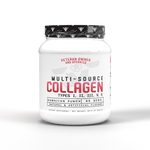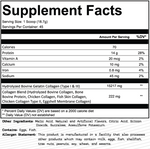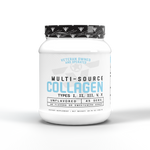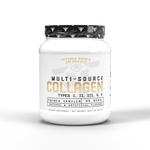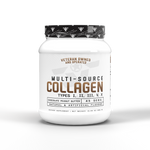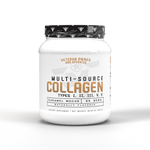
-
Description
-
Review
-
Shipping
-
Return
Multi-Source Collagen is carefully engineered and balanced for athletes, active individuals, and anyone looking for a premium collagen source in their diet.
Collagen is the most abundant protein in your body. It provides structure to your bones, connective tissues, muscles, hair, skin, nails, teeth, and organs. After the age of 25, the body’s production of collagen slows. We can curb this natural decline by consuming hydrolyzed collagen and effectively restoring collagen levels in the body.
There are multiple types of collagen, we’ve focused on 5 of them in our formulation from 4 sources: grass-fed, pasture-raised bovine, wild Alaskan pollack, chickens, and eggshell membrane. This four-origin land and sea approach brings the highest quality collagen types for full-spectrum effectiveness.
Science-Backed Product
- Type I Collagen
The most investigated collagen type, Type I is fibrillar—a triple helix matrix organized in fibrils which is essential for structural competence. Type I accounts for 90% of the body’s collagen. It is the key structural composition of all connective tissues and the interstitial membrane of skin, bones, tendons, and teeth. - Type II Collagen
Type II collagen is what gives cartilage its tensile strength and elasticity, thereby enabling it to support the joints. It’s found only in cartilage, which is critical for allowing tissue to bear mechanical stress, shock absorption, and connected bones to move without friction. Because cartilage is avascular, it’s particularly prone to wear and tear. - Type III Collagen
It is a major structural component in hollow organs such as blood vessels, gut, and uterus. Studies have suggested that its role is to act as a modifier of the fibril network composed of Type II Collagen together with other minor collagens during tissue healing. - Type V Collagen
Type V collagen is required for other types of collagen to form, fibrillogenesis, and to form correctly in both structure and matrix. - Type X Collagen
Type X collagen is a network-forming collagen, which is critical to bone density. It is considered a reliable marker for new bone formation.
For orders placed before 7am AEDT, we endeavour to process the same business day. Orders placed after 11am AEDT will be processed the next business day.
During sale events and new collection launches, there may be a slighly longer processing time.
All Auguste orders are hand-picked and packed with love from Byron Bay, Australie.
You can choose between a refund or a credit note on full priced items.
- Item(s) must be returned in their original condition and packaging: unworn, unwashed and with all tags attached.
- Earrings cannot be returned due to health and safety reasons.
- Return shipping methods and associated costs are the responsibility of the customer.
- Sale items can not be refunded for change of mind.








